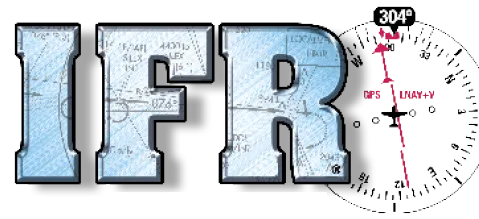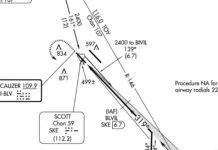How many of you file your own flight plan? How many of you file VFR flight plans? Of course, airlines have their own operations and dispatch departments who do all the background work and file the flight plans. With most Part 91 and some 135 operators, “Who filed what?” often gets to the person working clearance delivery, who has to sort it out to make sure your flight plan is good to go.
VFR vs. IFR
Filing a flight plan is something that is generally taught in primary training. My CFI taught me and made me file a VFR flight plan for my solo cross-country trips. Some pilots say that VFR flight plans are useless today, while some of us still use them. What are they good for? Well, search and rescue (SAR) for starters.
If you decide to fly VFR without flight following and don’t close the flight plan because you had an emergency with no time to tell anyone, a flight plan will be a big help. About 30 minutes after expected arrival time, FSS will start looking for you by calling any ATC facility along your route to see if you were on flight following or can be found using ADS-B. If unsuccessful, notice is sent to the proper authorities and the appropriate ARTCC that issues an alert notice (ALNOT). All this might save your life. I highly recommend VFR flight plans for student pilots on cross-country trips and anyone flying around mountains.
For IFR flight plans, as mentioned, most airlines and many 135 operators have someone other than the pilot filing the flight plan, but it’s the pilot who verifies the flight plan, picks up and accepts the clearance. Occasionally, systemic problems develop and even multiple flight plans can be filed. The pilots should feed this back to their flight departments as it creates unnecessary delays for that flight and the whole system.
The rest of us who file our own flight plans should do so carefully and know that basic procedures can make a difference.
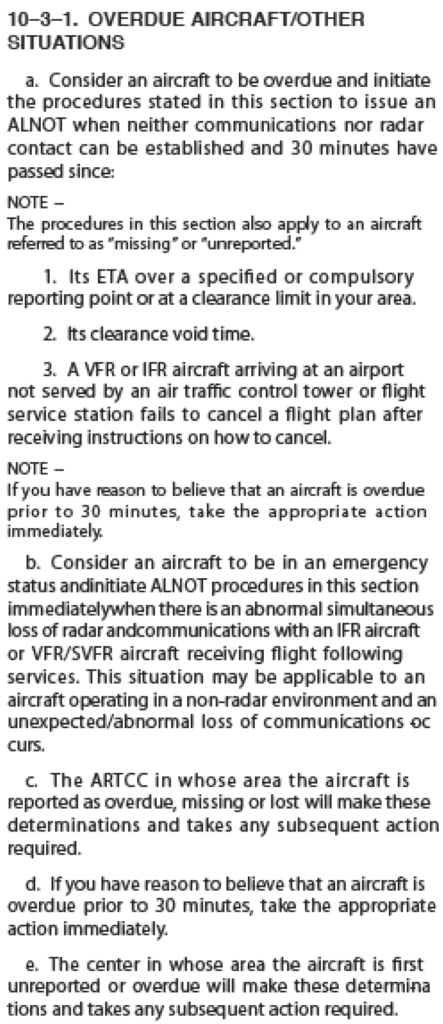
We all know the bare basics on a flight plan: callsign, type, departure and arrival, altitude, fuel, passengers, etc. These basics are rarely an issue. But I’ve seen pilots have issues with the equipment suffix, route, and (surprise!), proposed departure time. When you file an IFR flight plan, wait for it to be accepted. Whether it’s via your EFB, FSS, or another system, it must be accepted before ATC can access it. If you just push the button and move on, it might not pass the system’s validation tests.
In Tower I can’t see a flight plan if the system hasn’t accepted it, or if more than 24 hours before proposed departure time. Assuming the system has accepted it, it should be in the system and retrievable by controllers from the FDIO (Flight Data Input/Output system). Otherwise, IFR flight plans pop out of the printer (including a squawk) onto a flight progress strip 30 minutes before proposed departure time.
Assuming your flight plan made it through the trials and it now sits in front of me working clearance delivery, I have a flight progress strip with your callsign, wake turbulence class (for ATC use only), equipment suffix, internal system computer ID number, squawk, proposed departure time in Zulu, requested final altitude, departure and arrival airports, and complete route with any remarks. If the route goes off the strip, I can print another strip with full route.
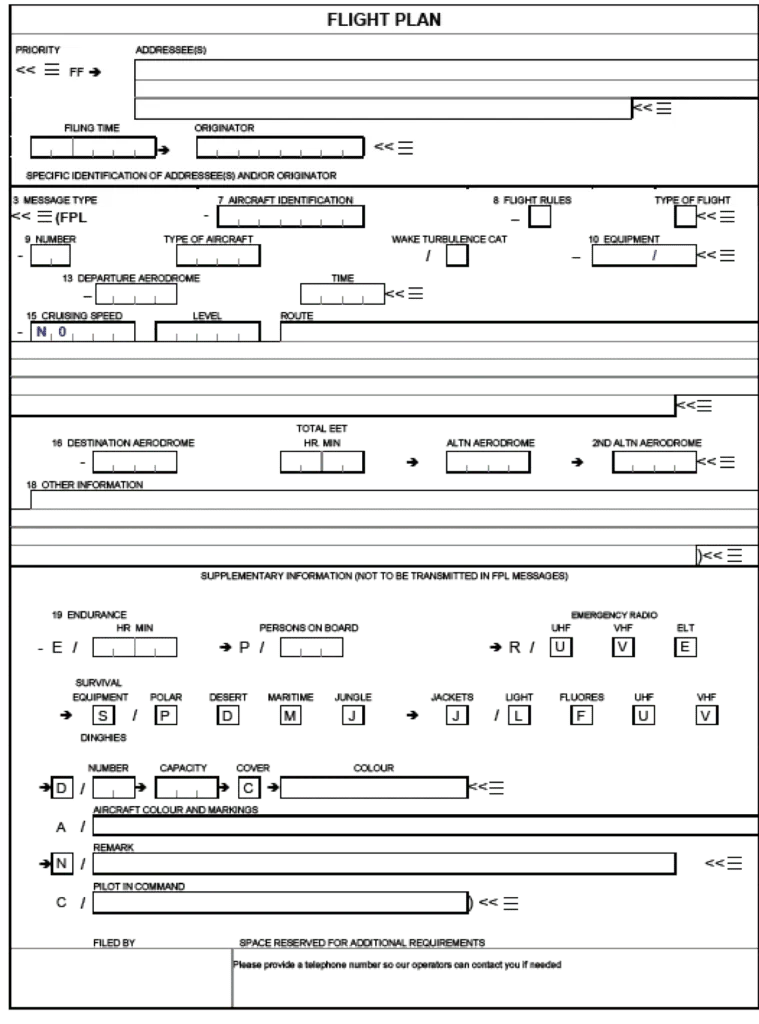
When “They” File For You
More than 75 percent of IFR flights are flown by airlines. Their operations or dispatch will create the entire flight plan and file it. Of course, the PIC remains the final authority and can make changes, but usually doesn’t see it until close to departure time. If significant changes are needed, the pilot should usually work with their company to make the adjustments.
Many Part 135 carriers and even some Part 91 operators also have others file the flight plans. Same deal. As a Class D Tower guy, I sometimes read a clearance and get a confused response. “Uh we filed for this?” Or “I think my company goofed.” My personal favorite is when they say, “Hmmm… That’s not our destination.”
One of the biggest problems I see are errors on equipment suffix, proposed time (maybe local to Zulu confusion), and altitude. The equipment suffix of your airplane and the requested altitude play a big factor in route, especially through busy airspace. Those two little details could have a jet flying too low, or a prop higher than able.
I also get military flights that file a /G (GNSS) and then say they can only fly VOR routes. We usually tell them to re-file with the correct suffix. Sometimes this can be overridden when airborne, but it adds a non-trivial workload to the system. We’ll get to why it’s a challenge for ATC to fix.
Your takeaway from all this should be to file as accurately as possible and pay particular attention to your equipment suffix, TAS, filed altitude, and proposed departure time. Overall, the NAS does not drastically change in a split second, however there will come a time where one intersection will move you out of the way, just enough to comply with traffic, airspace, TFRs, etc. Flight plans are not set in stone, so pilots who fly those routes should remain flexible to changes, and also know when to say “unable.”
ATC To the Rescue?
Even after exercising significant care preparing the flight plan, there can always be a few little errors and ATC can help with some. Most clearance delivery controllers have access to a FDIO. In this old “DOS”-style system, we can create entire flight plans, amend them, and delete them.
We usually don’t create flight plans—you know the details of your flight but we don’t. I’ve only created a flight plan from scratch once; I had a Phenom taxi out for departure with their clearance and everything was good to go. When we tried to get the release, the system said there was no flight plan. After a few minutes and some calls, I couldn’t access the flight plan and told the pilot we’d start over.
I switched him back to clearance frequency. With his original flight progress strip in front of me already, all I really needed was the expected TAS. I entered all the info and got a new flight plan for him, re-issued the whole thing with new squawk and he was good to go. We got his release and he departed. When pilots file, they enter their name, airplane colors, number of passengers, and other personal info that ATC doesn’t need to know, but FSS and the system as a whole does require. Sometimes ATC will ask you for this info, but since we cannot add this from our system, we would have to collect the info and pass it along to FSS.

We will often amend departure times. Many pilots have multiple legs in a day, so they file all the legs at once as close as possible. Some pilots pick up their next clearance before they land or as they taxi to park. Remember, flight plans print out of the system 30 minutes before the proposed departure time. If you call ATC before those 30 minutes, they’ll not likely have your flight plan in hand, so they ask the proposed departure time. As long as it’s within 24 hours and the system has acknowledged your flight plan, we can dig it up.
If I don’t find it, I’ll ask the pilot to re-file. If I do find it, I will confirm their intended departure time or if they are trying to go sooner. I check for EDCT times before amending a proposed departure time, lest I make the pilot and passengers wait a lot longer than needed. Assuming no EDCT times, I simply amend the proposed departure to within 30 minutes of the current time, then it will print out. On the other side, flight plan drop times (out of the system) vary based on location, and can change due to weather. In my area, they are good for three hours and extend to four for bad-weather days.
We also often amend route. Sometimes we’ll see an unnecessary VOR or intersection in the route, especially when the two airports are close together. We will simply amend the route to eliminate the unnecessary stuff. The system occasionally does this if it thinks the flight still needs a starting point and it pulls that from local departure procedures, such as flights going from one side of a Class B to the other.
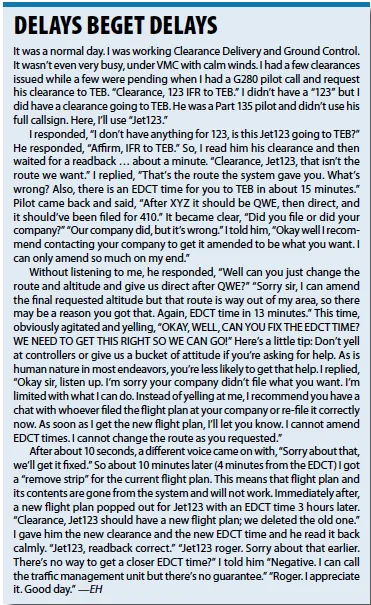
Cleared … As Filed
Flight plan routes should be kept as efficient as possible. Aeronautical decision making starts well before a flight begins. Keeping efficiency and accuracy as high as possible reduces unnecessary work and delays for everyone. While incorrect flight plans aren’t big hot buttons in the NAS, they can attribute to them by taking attention away from other controller duties. Moving aircraft is the priority over clearances but we’ll do what we can to help as appropriate. File correctly; fly safe.
Elim Hawkins works Tower at a busy Class D airport and advises staying ahead of the airplane, and that starts with proper flight planning.

